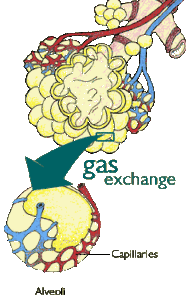Introduction
The main purpose of breathing is to supply the body with sufficient oxygen and to remove excess amounts of carbon dioxide.
Respiration can be examined at two levels, one large and one small. At the lung or large level, respiration brings about gas exchange by breathing. At the cellular or small level, oxygen transforms the food we eat into energy, producing carbon dioxide as one by-product.
The focus here first of all is on the lung level. This is because you cannot really understand what asthma is, unless you have a basic understanding, of the respiratory system.
The Nose
The nose is not simply a passageway to our throat. Within the skull, it is an extensive array of passageways with inner walls covered by a sticky layer of mucus. The walls are richly supplied with heat-radiating blood vessels.
The nose is like an air-conditioner – it prepares or conditions the air for the lungs. When you breathe through your nose the air is:
warmed – air is warmed by the blood vessels, so it is at the right temperature when it reaches the bottom of the throat (The lungs have a strong aversion to cold air)
filtered – dust particles are trapped by tiny hairs and mucus in the nose (which then travels to the throat to be swallowed)
humidified – the air is 100% humidified by the mucus in the nose
This “treated” air passes down through the throat, and into the trachea. The airways are built like an upside-down tree, with the trunk (trachea) branching out into a series of medium size branches (bronchi) that separate into smaller branches(bronchioles). The trachea, bronchi and bronchioles are collectively known as the airways and they are wrapped in a layer of smooth (involuntary) muscle.
The bronchial tubes
The inner lining of the bronchial tube is a delicate membrane called the bronchial mucosa. During an asthma attack, this membrane becomes swollen and inflamed. Wrapped around the walls of your bronchial tubes is a layer of smooth muscle, which is capable of contracting, producing airway narrowing or bronchoconstriction. Mucus glands located within the layers of the bronchial lining can produce large quantities of extremely thick mucus when stimulated.
The Alveoli where gas exchange takes place
At the end of the smallest bronchioles and at the edge of the lungs are millions of air sacs or alveoli. Think of these air sacs surrounding the bronchioles as a bunch of grapes hanging off a stem. The walls of your alveoli are only one cell thick. This combined with the moist atmosphere of the lungs allows oxygen and carbon dioxide molecules to pass through. Outside the lungs and surrounding the air sacs is a network of capillaries which, also have walls one cell thick.
The alveoli contain air rich in oxygen and low in carbon dioxide. The blood in the capillaries contains less oxygen but more carbon dioxide. Gas always tries to equalise pressure levels and so oxygen passes from the alveoli into the capillaries. Simultaneously carbon dioxide passes from the blood into the alveoli. The blood now leaves the alveoli oxygen-rich and the excess carbon dioxide is breathed out. This is gas exchange at the large (lung) level.

Oxygen combines with haemoglobin molecules in the bloodstream and travels from the lungs to the heart. Now with haemoglobin full of oxygen, the blood is pumped around the body, supplying oxygen to the cells and tissue.
Cellular Gas Exchange
Gas exchange at the smaller or cellular level is the reverse of that at the large (lung) level.
Gas exchange at the smaller or cellular level is the reverse of that at the large (lung) level. Tissue cells have high levels of carbon dioxide & low levels of oxygen. In the tiny blood vessels running past the tissue, oxygen levels are high and carbon dioxide levels are low. Both the cell walls and the capillary walls are one cell thick and so gases move from one to the other equalising the pressure.
The tissue cells to make energy use oxygen. As a result, carbon dioxide and water are produced. They pass from the cell to the bloodstream and oxygen moves in to produce more energy. The gas exchange cycle repeats itself continuously (more than 60 times a minute) at both the large and small levels.
